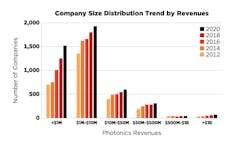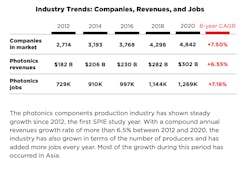Continued growth is always exciting—and there is a lot to be excited about within the optics and photonics industry. Despite the many challenges facing manufacturers, steady growth continues within the increasingly horizontal global market.
According to the SPIE’s 2022 Fall Update to its Industry Report, the core photonics market exceeded $300 billion for the first time in 2020 and has subsequently grown at a compound annual growth rate (CAGR) of 7.5%. In addition, SPIE updated its forecast, anticipating global photonics component revenues between $309 billion and $325 billion in 2022.
The new report draws its conclusions based on SPIE’s data from 4842 global manufacturing companies spread across 50 countries. These companies produce core photonics components and employ over 1.2 million people worldwide. When breaking the numbers down by country, Japan, the United States, China, and South Korea contribute the bulk of the revenue, with the U.S. and Japan combining to account for more than 55% of the total component revenue.
SPIE’s report also offered insight into the average revenue per employee across optics and photonics companies. This number serves as a measure of how efficiently companies utilize employees, with relatively high revenue per employee suggesting operational efficiency. When looking at revenue per employee in the larger photonics community, the range varied from $100K per employee to over $1 million, with an average revenue per employee of $238,005.True enabler
As photonics technology continues to stretch across a vast array of industries, it has been settling into a noticeable role as the enabler of many other technologies. The SPIE report takes this expanded reach into account with an updated assessment of the photonics-enabled market.
Specifically, SPIE tracks 10 major “photonics-enabled” end-use market segments dependent on photonics technologies and innovations. The enabled markets include advanced manufacturing, sensing, lighting, displays, solar, biomedical, communications, semiconductor, defense, and consumer products.
SPIE’s analysis shows the total enabled market economic impact of photonics exceeded $2.12 trillion worldwide in 2021.
Strong growth areas include consumer products, sensors, autonomous systems, solar, and semiconductor processing, where SPIE expects increased growth stimulated by legislation such as the U.S. CHIPS and Science Act as well as the European Chips Act of 2022. Expecting more growth out of the semiconductor processing space is not unwarranted. According to the numbers of the enabled markets SPIE is tracking, semiconductor processing already ranks as the largest growth segment based on its CAGR of 24%.
About the Author
Peter Fretty
Market Leader, Digital Infrastructure
Peter Fretty began his role as the Market Leader, Digital Infrastructure in September 2024. He also serves as Group Editorial Director for Laser Focus World and Vision Systems Design, and previously served as Editor in Chief of Laser Focus World from October 2021 to June 2023. Prior to that, he was Technology Editor for IndustryWeek for two years.
As a highly experienced journalist, he has regularly covered advances in manufacturing, information technology, and software. He has written thousands of feature articles, cover stories, and white papers for an assortment of trade journals, business publications, and consumer magazines.


